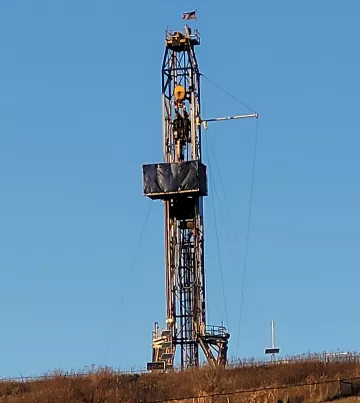Written by: Dr. Randi Pokladnik
The Ohio Senate Republicans recently passed the Amended HB 507 bill. The bill was originally intended to address poultry sales and food safety, however, at the last minute an amendment (134-3853) was added to HB 507 in the Senate. Basically, the amendment will force state agencies to open their land to oil and gas drilling with no exceptions. The amendment creates an atmosphere where citizens are basically locked out of any public review process and refused the ability to make comments on the leasing process. It by-passes any considerations of impacts to the environment and recreation.

Pre-19th century, Ohio was 95 percent forested. Today, only 30 percent of forested land remains (8.0 million acres) and only 11 percent is owned by state and local governments. The Ohio State Park system encompasses about 170,000 acres of land and over 31 million visitors come to Ohio parks each year.
For many people, both in and out of the state, the state parks and forests remain a sanctuary; a place for them to escape their hectic lives and find the peace that nature offers. It also provides a space for recreating, bird watching, fishing, hunting, hiking, canoeing, and biking. Additionally, a study by The Ohio State University determined that outdoor recreationalists’ trips bring in $8.1 billion to Ohio’s economy and the sector employs 133,000 workers.
Fracking and all the build-out that the oil and gas industry requires will dramatically change the landscape of Ohio’s parks and forests. Who wants to hike through a park with frack pads and fracking infrastructure? Who wants to ingest wild game and fish taken from areas where fracking is occurring? Since 2005, and the passage of the federal Energy Policy Act, also known as the Halliburton Loophole, the fracking process remains virtually unregulated. Who will guarantee that every stage of the process will be conducted in a way so as not to disrupt the state lands that supposedly belong to Ohio’s citizens?
A study in West Virginia showed forest ecosystems are negatively affected by forest clearing, erosion, and road building during fracking. Vegetation death was also noted after frack fluids were sprayed on the surrounding trees. Peer reviewed studies show that watersheds surrounding frack well pads test positive for the radioactive substances found in frack waste water, which consists of fracturing fluid and salts, heavy metals, hydrocarbons, and radioactive material accumulated from natural underground sources.
Fracking well pads and infrastructure will require clearing areas (cutting trees and vegetation). This will require areas of anywhere from four to twenty-five acres. Not only will this fragment the forest, it will cause other effects that to date are still not clearly understood or studied. This includes additional fragmentation that could affect plant reproduction. Fracking can also introduce and encourage the spread of invasive species via the gravel delivered to build pads and roads, and in mud on the tires and undercarriages of trucks traveling those roads.
Traffic in the region will increase tremendously, becoming a maintenance burden on roads, and also a hazard to local citizens and visitors. Each well drilled requires approximately 592 one-way trips, with a truck that carries between 80-100,000 lbs of toxic radioactive oil and gas waste. The traffic from the development of one well is equivalent to 3.4 million car trips.
The process of high-pressure hydraulic fracking necessitates the use of 4-6 million gallons of water per well. This surface water will no doubt be withdrawn from the local streams, resulting in harm to aquatic organisms. Fracking fluids contain chemical additives, e.g. friction reducers, biocides and surfactants, many of which are known carcinogens and endocrine disruptors. Very little is known about the potential effects of the chemicals, metals, organics or other contaminants once they enter terrestrial or aquatic food webs.
Climate change, the elephant in the room, is being exacerbated by our reliance on fossil fuels. Fracking operations release fugitive methane emissions and are much higher than the industry reports. Methane gas is about 86 times as potent as carbon dioxide in magnifying heat related to climate change. The aesthetic beauty as well as biodiversity of the forest will be impacted by allowing fossil fuel companies to frack the landscape.
Once again, Ohio’s politicians place the interests of the oil and gas industry ahead of Ohio’s citizens.
Biography of Dr. Randi Pokladnik:
Dr. Randi Pokladnik was born and raised in the Ohio Valley. She earned an associate degree in Environmental Engineering, a BA in Chemistry and an MA and Ph.D. in Environmental Studies. She is certified in Hazardous Materials Regulations and has a teaching license in Science and Math. She worked as a research chemist for eleven years at the National Steel’s Research Center in Weirton, WV. She has taught both secondary and post-secondary science courses. She now volunteers for several environmental non-profits in the Ohio Valley, including the Mid-Ohio Valley Climate Action and Faith Communities Together for a Sustainable Future (FaCT Ohio).
She has received several awards including the Eastern Gateway Community College’s Outstanding Alumnus of 2018, Ohio Valley Environmental Coalition’s Community Networker of the Year for 2015, Fractivist of the Year in 2018 and in 2020 the Laura Forman Passion for Justice Award. She was nominated for a Community Sentinel Award in 2019 for her efforts to educate the public on the hazards of plastic cracker facilities.
Her research includes examining the threats to non-timber forest products in Appalachia. She also is focused on climate change and how forests can be used to mitigate carbon emissions.
She resides with her husband at Tappan Lake in an eco-log home that they have built using sustainable building and design practices. She enjoys biking, hiking, and making wine with her husband.